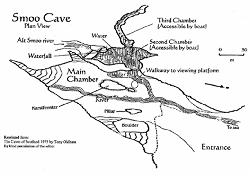Smoo Cave
by Tony Oldham
History

The name "Smoo" is thought to be derived from the Norse word "smjugg" meaning a hole. In 1992 an archaeological dig on a midden site inside the cave unearthed many interesting finds. The upper layers were Iron Age in origin making this one of the most northerly habitation sites in the British mainland. The midden was packed with shells, some of which can still be seen today poking through the top soil. Deeper levels were progressively older and the deposits at the base are thought to belong to the Mesolithic Period, when the earliest human inhabitants arrived in the Highlands. Much earlier in 1904 an organised excavation took place but a report was never published.
Among the many local legends surrounding the cave is that of the feared highway man McMurdo. Legend has it that during the sixteen century, McMurdo murdered his victims by thowing them down the blowhole into the cave. You can still see McMurdo’s tomb at Balnakeil Church which overlooks nearby Balnakeil Bay.
By far the most colourful tales of Smoo are those told about the first Lord Reay, Master of MacKay, Donald of MacKay, known as the Wizard of Reay. It is said that in former times there was an iron ring in the wall of Geo Smoo where Reay used to chain his transgressors, who were left to drown at high tide. Whilst exploring the further reaches of the cave Reay came across a small wooden cask. He pulled out the plug and out crawled a tiny man 5 cm in height. The man quickly grew into a giant and turned out to be the devil who cried out "Well now Donald, what are you going to do now". Donald quickly regained his senses and suggested to the devil that if he really wanted to impress him he should resort to his original size. The devil obliged and Donald quickly stuffed him back in the cask and replaced the plug. I hope that any cavers exploring the inner reaches of Smoo Cave will take note.
Any cave located on or near the coast is a natural warehouse for "duty free" goods. Smoo Cave is ideally situated as it has access from the sea via a long and narrow sea loch called Geo Smoo, where high cliffs provide shelter even in the roughest of weather.
The cave has been the scene of many historical visitations, see list of references, but the best account is by Sir Walter Scott, after a visit in 1814
( Lockhart).
Lockhart).
Geology
The cave is formed in a band of Durness limestone which in turn is surrounded by quartzite, gneiss and grits. Originally a small swallet cave, the entrance has been much enlarged by the action of the sea.
Description
A steep footpath leads down to the vast entrance 33 m wide and 16 m high. The floor of the main chamber is barely a metre above normal high tide mark, and is covered with sand and boulders. On the right of this chamber a small stream enters. This is the Allt Smoo, which sinks down a 21 m pothole, which may be seen on the other side of the road from the footpath. In 1986 the cave was modernised and the footpaths improved. It is now possible to do a round trip, down one flight of steps and go back up to the road via another pathway. This gives an excellent view of the karstfenster. Another improvement has been the addition of a covered bridge which was placed across the first lake. Although the tour is self guided, in August a local entrepreneur provides a boat tour across the third lake. This leads to 16 m of low wet passage. At the same time, lights were installed in the cave. The lights are on all the time and have produced a fine display of lampenflora.
Respectfully submitted by Tony Oldham September 2002
 Index
Index Topics
Topics Hierarchical
Hierarchical Countries
Countries Maps
Maps Search
Search